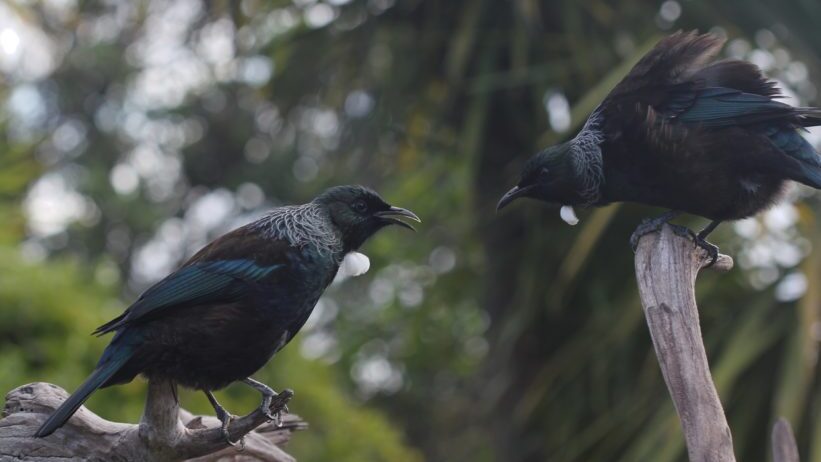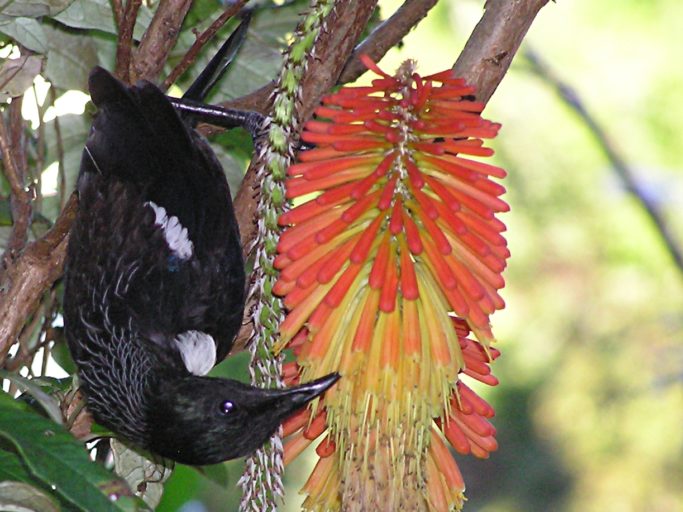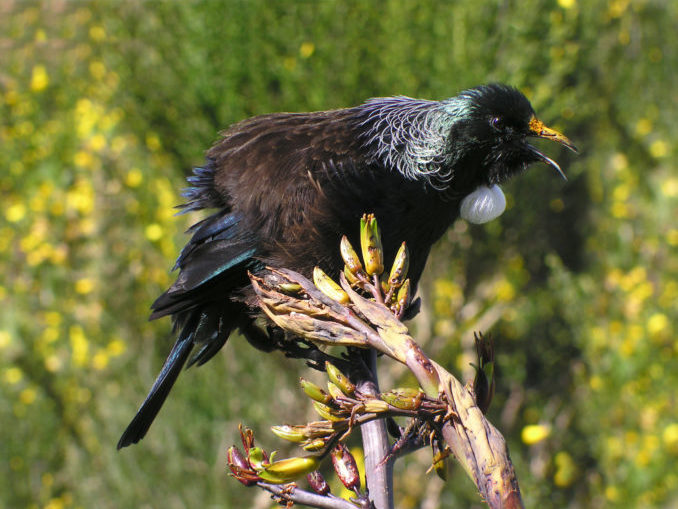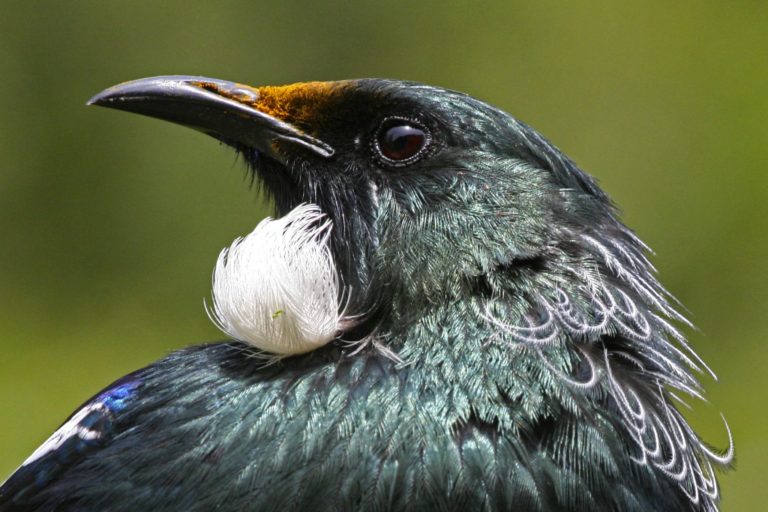We New Zealanders love our tūī. Maybe its their feisty, humorous territorial antics. Or maybe it’s the melodious calls interspersed with those ridiculous ‘snorts’. Perhaps its the iridescent black/green/blue/purple of their feathers.

Whatever the reasons, tūī are warmly welcomed into our gardens and when predator control and habitat restoration lead to a surge in native bird numbers, its often the increasing number of tūī that we remark on (and boast about). How many tūī have you seen at one time or managed to photograph in one image?
Not surprisingly, the iconic tūī features kiwi imagery and brand names too, from beer brands to garden products to postage stamps.
The tūī is a member of the honeyeater family. It has a curved bill and a long tongue, frayed at the end like a brush, which is used to reach deep into flowers and drink nectar. Like our other honeyeater, the bellbird, tūī feed on a mixture of nectar, fruit, and insects and happily feed from garden bird-feeders. (Incidentally, nectar-mixtures or sugar-water should be used in feeders, never honey which can spread diseases between bees).
Tūī can be dominant characters – aggressive and pugnacious, which probably accounts for their successful survival on the mainland. They will chase the weightier but gentle kereru and have been known to attack hawks and magpies—although tūī have also been recorded as being victimised by mobs of mynas and starlings.

Humans have also helped tūī thrive by introducing new, nectar-rich plant species to our suburban gardens. Tūī will defend a flowering or fruiting tree, or a small part of a large tree, from all-comers, whether a rival tūī or another bird species. They vigorously chase other birds away from their feeding territory with loud whirring wings and have a display flight, in which they fly upwards above the canopy, and then make a noisy, near-vertical, dive back into the canopy.
In flight, their bodies slant with the head higher than the tail, and their noisy whirring flight is interspersed with short glides. Older, dominant male birds make the loudest, most aggressive whirring sounds in flight. Adult birds have a notch on the 8th primary wing feather and this feather quivers from the narrow part creating that typical whirring sound.
Tūī are one of the most common pollinators of flowering plants and this play an important role in the dynamics of New Zealand forests. As they dip curved beaks into similarly curved flower hoods and curl their brush-tipped tongues into the nectar of mahoe, rewarewa and other flowering natives, the bird’s forehead is smudged with pollen. The pollen is transferred to another plant when the tūī moves on to take its next drink. They also disperse the seeds of trees with medium-sized fruits.
Typical calls consist of rich, fluid, melodious notes intermixed with croaks, coughs, clicks, grunts, wheezes, squeaks, buzzes and chuckles. Tūī also harass raptors with a repetitive screaming sound. They are great mimics and can copy other species and even imitate human sounds. They can exactly re-create sounds—as specific as glass shattering—and they frequently pick up on more everyday sounds such as car alarms, beeps and whistles.

Watch a singing tūī closely and you might notice that it seems to huff and hunch in silence between chord progressions as if gearing up for its next rendition. This is when the tūī reaches ultra-sonic notes and, for those seconds, sings a melody that humans are unable to hear.
The tūī’s clever mimicry meant they were popular pets in earlier times, as well as being a valued food source.
Tūī were the most common passerine (perching bird) found in Maori middens and were probably once an important source of protein. Early European settlers apparently ate them in pies and sometimes used the skins for decoration on ladies’ hats. Early settlers also kept pet tūī, as did Maori, and there are several accounts of tūī that had been taught to talk and sing. These highly prized birds aroused envy—a legend from the Wairoa region tells about Tane Miti Rangi, a tame tūī that caused an inter-tribal war when he was stolen by a neighbouring hapu.
Tūī are widespread and locally abundant on the North, South and Stewart Islands, and their offshore islands; they are scarce only in drier, largely open country east of the Southern Alps, in Canterbury for example. Tūī are present on the Kermadec and Auckland Islands, and there is a larger subspecies endemic to the Chatham Islands. Tūī are absent on the Poor Knights Islands probably due to the very high density of bellbirds there competing for a limited nectar resource.

Tūī are found in native forest and scrub (sometimes in exotic forests), and in rural gardens, stands of flowering kowhai and gums, and in suburban parks and gardens. Tūī move around locally, following a seasonal succession of flowering or fruiting plants. They usually nest in native forest and scrub but will commute more than 10 km daily to feed on rich sources of nectar.
Despite the loss of the vast majority of lowland forest in New Zealand, tūī have probably benefitted from the introduction to New Zealand of a variety of flowering and fruiting plants. These new species, as well as ‘out-of-range’ plantings of native species and sugar-water feeders in gardens, now provide tūī with a reliable year-round supply of nectar and fruit. Tūī also respond extremely well to pest control programmes targeting possums, rats and mustelids, which are probably their main nest predators. So keep trapping those predators and see how many tūī you can count chasing each other around your garden.

